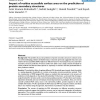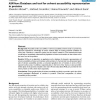27 search results - page 1 / 6 » Impact of residue accessible surface area on the prediction ... |
111
Voted
BMCBI
2008
15 years 11 days ago
2008
Background: The problem of accurate prediction of protein secondary structure continues to be one of the challenging problems in Bioinformatics. It has been previously suggested t...
108
click to vote
BMCBI
2004
15 years 4 days ago
2004
Background: Accessible surface area (ASA) or solvent accessibility of amino acids in a protein has important implications. Knowledge of surface residues helps in locating potentia...
BMCBI
2006
15 years 9 days ago
2006
Background: The residue-wise contact order (RWCO) describes the sequence separations between the residues of interest and its contacting residues in a protein sequence. It is a ne...
114
click to vote
BMCBI
2008
15 years 11 days ago
2008
Background: Residue depth allows determining how deeply a given residue is buried, in contrast to the solvent accessibility that differentiates between buried and solvent-exposed ...
121
click to vote
ICASSP
2007
IEEE
15 years 6 months ago
2007
IEEE
Protein structure prediction aims to determine the three-dimensional structure of proteins form their amino acid sequences. When a protein does not have similarity (homology) to a...


